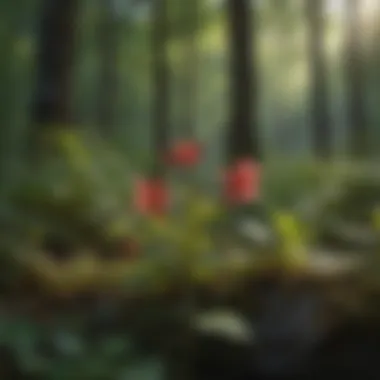Eastern Red Columbine Seeds: Ecology and Cultivation


Intro
Eastern red columbine seeds, derived from the Aquilegia canadensis, play a significant role in their native ecosystems. This plant is not merely an ornamental beauty; it serves various ecological functions. Understanding the importance of this species extends beyond just recognizing its aesthetic charm. This article delves into its biology, conservation, and practical applications, specifically in the context of woodland ecosystems.
Understanding Woodland Ecosystems
Eastern red columbine seeds contribute to the complex interrelations within woodland ecosystems. In these environments, biodiversity sustains ecological balance and enhances the resilience of ecosystems against disturbances. The presence of diverse plant species, including Aquilegia canadensis, supports a myriad of animal species, including pollinators crucial for reproduction.
Importance of Biodiversity in Forests
Biodiversity fosters stability. A varied ecosystem improves soil health, water quality, and contributes to carbon sequestration. By attracting various species, the eastern red columbine not only enriches its habitat but offers food sources for hummingbirds and butterflies, contributing to the cycle of life that supports other flora and fauna.
Role of Forests in Climate Regulation
Forests are vital players in climate regulation. They act as carbon sinks, absorbing carbon dioxide and releasing oxygen. The growth of native plants like eastern red columbine fosters a healthy understory, which can improve forest resilience to climate changes. Through effective photosynthesis, these plants assist in mitigating climate impacts.
“Maintaining biodiversity within forests is essential for sustaining ecological functions and services.”
Sustainable Forestry Practices
To maximize the ecological benefits of eastern red columbine, sustainable forestry practices are essential. These practices aim at responsible resource management while ensuring the health of ecosystems.
Principles of Sustainable Forestry
Successful forestry management integrates ecological, social, and economic considerations. Key principles include:
- Conservation of biodiversity
- Ecosystem service resilience
- Sustainable yield of resources
- Community involvement
Case Studies of Successful Implementations
Several regions have exemplified sustainable forestry. In the Midwest, practices that incorporate native species, including eastern red columbine, have shown improved ecosystem health and tree growth rates. By creating environments suitable for diverse plant life, these efforts highlight the opportunities gained through integrating native species into forestry practices.
Woodland Stewardship Techniques
Effective stewardship is integral to the longevity of forests. This encompasses various techniques that ensure a balanced approach to resource use and conservation.
Forest Management Plans
A robust forest management plan considers the unique characteristics of each woodland. These plans identify priority areas for eastern red columbine growth while also setting guidelines for harvesting and restoration. They serve as operational roadmaps to manage both ecological and economic interests.
Conservation Strategies
Active conservation strategies for eastern red columbine seeds involve:
- Seed bank initiatives to preserve genetic diversity.
- Habitat restoration projects to repair degraded areas.
- Public education programs to raise awareness on the importance of native species.
In summary, appreciating the eastern red columbine seeds in the context of woodland ecosystems offers insights into their vital ecological roles. From enhancing biodiversity to informing sustainable forestry practices, these seeds are integral to maintaining healthy forests.
Preamble to Eastern Red Columbine
The Eastern Red Columbine, scientifically known as Aquilegia canadensis, is a noteworthy plant species native to North America. This section seeks to underscore its relevance in the context of ecological stability and biodiversity. Understanding this plant's characteristics, propagation, and its historical context can greatly benefit both forestry professionals and amateur gardeners looking to utilize its beauty in ecological landscaping.
The Eastern Red Columbine thrives in various environments, offering flexibility in its cultivation. This adaptability makes it an excellent candidate for conservation efforts and ecological landscaping. Furthermore, a solid grasp of its biological foundations allows individuals to appreciate its role in local ecosystems. People interested in sustainability and natural gardening find that incorporating native species like the Eastern Red Columbine into their practices leads to improved biodiversity.
Botanical Overview
The botanical profile of the Eastern Red Columbine reveals a plant with distinctive features. This perennial herb can reach heights of 30 to 90 centimeters. The leaves are compound and deeply lobed, typically emerging from a cluster at the base. The flowers, which bloom from late spring to early summer, display a vibrant red coloration. They are characterized by their unique spurred shape, attracting various pollinators, especially hummingbirds.


Furthermore, the columbine's seeds are small, lightweight, and easily dispersed by wind, contributing to its spread across suitable habitats. Such characteristics aid in understanding how this species occupies and thrives in diverse environmental conditions. With proper knowledge and techniques, the cultivation of this alluring plant becomes increasingly achievable.
Historical Significance
Historically, the Eastern Red Columbine has a rich significance in both indigenous and modern contexts. It was recognized for its aesthetic appeal and medicinal properties. Native American cultures often utilized parts of the plant for various healing purposes. This connection highlights the interrelation between people and plants, where knowledge of the natural world informed survival strategies.
In contemporary times, the Eastern Red Columbine serves as more than just a landscape choice. The resurgence of interest in native plants encapsulates broader trends in environmental stewardship and sustainable gardening. Its historical importance informs not only cultural heritage but also contemporary ecological practices. Thus, integrating this species into modern landscaping not only preserves its legacy but also enriches the ecological tapestry of local environments.
Incorporating native species like Eastern Red Columbine into landscapes helps maintain ecological balance and fosters biodiversity.
This foundational understanding sets the stage for deeper discussions about the ecological implications and practical uses of Eastern Red Columbine seeds in subsequent sections.
Ecological Importance of Eastern Red Columbine Seeds
The ecological importance of Eastern Red Columbine seeds is deeply rooted in their contributions to various ecosystems. Aquilegia canadensis, commonly known as Eastern Red Columbine, is not just a visually appealing plant but also plays a significant role in maintaining biodiversity within its habitat. By attracting specific pollinators and providing food sources for various species, these seeds are crucial in sustaining the ecological balance.
Role in Biodiversity
The role of Eastern Red Columbine seeds in biodiversity is particularly notable. They serve as a food source for numerous organisms, including birds and small mammals. These seeds are also vital for certain pollinators, such as hummingbirds and bees, that are drawn to the plant’s unique flowers. This attraction facilitates cross-pollination, which enhances genetic diversity within the plant population and ultimately fosters a healthier ecosystem.
In addition, by supporting various species of wildlife, Eastern Red Columbine seeds contribute to a rich tapestry of life within their natural environment. The presence of such diverse flora effectively sustains different food webs and contributes to the resilience of ecosystems, enabling them to better withstand environmental changes.
Habitat Contributions
Eastern Red Columbine seeds play an essential role in habitat contributions as well. The germination and growth of this plant can aid in stabilizing soil, thereby reducing erosion in various environments. Their root systems penetrate deeply into the ground, anchoring the soil and preventing sediment runoff.
Moreover, Eastern Red Columbine contributes to soil health by adding organic matter and nutrients back into the earth as the plant senesces. This process supports the growth of other flora in the vicinity, enhancing the habitat's overall productivity.
Additionally, as a native species, Aquilegia canadensis is well-adapted to local climate conditions. This adaptability means that it requires fewer resources to thrive than non-native species, making it a more sustainable option for landscaping and restoration efforts. Thus, integrating Eastern Red Columbine into these efforts not only promotes biodiversity but actively supports ecosystem health.
"Eastern Red Columbine seeds are more than just a component of native ecosystems; they are a vital link in the chain of ecological health and sustainability."
In summary, the ecological importance of Eastern Red Columbine seeds cannot be overstated. They support biodiversity, contribute significantly to habitat structure, and offer numerous benefits to the ecological community. Understanding these roles is imperative for those involved in forestry, conservation, and ecological landscaping.
Biological Characteristics
Understanding the biological characteristics of Eastern Red Columbine seeds is essential for both practical applications and ecological studies. The unique traits of these seeds determine how they interact with their environment and contribute to the ecosystem. Knowledge of seed morphology and the processes involved in germination will greatly enhance cultivation efforts and promote sustainable practices.
Seed Morphology
The morphology of Eastern Red Columbine seeds is intriguing and plays a vital role in their development and adaptability. These seeds are small, typically measuring around 4-5 mm, characterized by their flattened shape and smooth surface. The dark brown color allows them to blend in with the forest floor, which may help with seed dispersal and protection from predators.
The seed coat is relatively thin, suggesting that it can be permeable enough to allow the passage of water. This characteristic is important for promoting germination under suitable conditions. Furthermore, the embryos within the seeds are well developed, reflecting their potential for successful germination once environmental conditions are met. The morphology of these seeds directly impacts their dispersal mechanism, often facilitated by wind or water as well as wildlife, which can consume and later excrete them, aiding in colonization.
Germination Process
The germination process of Eastern Red Columbine seeds is a complex and critical stage in their life cycle. Generally, seeds require specific environmental conditions to germinate successfully. The two main processes that influence germination are scarification and stratification.
Scarification involves the physical alteration of the seed coat to promote water absorption. This can be done through mechanical means or by natural processes such as being consumed by animals. Cold stratification, on the other hand, mimics winter conditions necessary for the seeds to break dormancy. This usually requires prolonged exposure to cooler temperatures and moist conditions, typically lasting several weeks.
The germination rate can vary significantly, often depending on the timing and method of stratification. Once conditions are favorable, seeds will absorb water, swell, and the embryo will begin to grow. Eventually, this results in the emergence of the seedling.
Understanding these biological characteristics is crucial not only for enthusiasts and horticulturists but also for the preservation of local biodiversity.
In summary, the biological characteristics of Eastern Red Columbine seeds, including their morphology and the germination process, provide insight into how these seeds thrive in their natural habitat. By appreciating these elements, practitioners can improve cultivation techniques, contributing to biodiversity and sustainable woodland management.
Cultivation Techniques for Eastern Red Columbine


Cultivating the Eastern Red Columbine, or Aquilegia canadensis, requires a deep understanding of its specific growth needs. This section elaborates on optimal growing conditions, effective propagation methods, and essential pest and disease management strategies. Understanding these cultivation techniques is crucial for both enthusiasts and professionals who wish to successfully integrate this native species into various ecosystems.
Optimal Growing Conditions
The Eastern Red Columbine thrives in well-drained soil and prefers a sandy or loamy texture. A slightly acidic to neutral pH is ideal, typically ranging between 6.0 and 7.0. These plants are versatile; they can grow in part to full shade, which makes them suitable for woodland gardens and shaded areas. However, exposure to too much sunlight can lead to wilting and poor flower production.
Watering is essential during the establishment phase. Consistent moisture encourages healthy growth, but Aquilegia canadensis is also drought-tolerant once established. A layer of mulch can assist in moisture retention while suppressing unwanted weeds around the base of the plants.
Propagation Methods
Effective propagation is vital for maintaining healthy populations of Eastern Red Columbine. Two primary methods are often employed: scarification and cold stratification.
Scarification
Scarification is the process of mechanically or chemically breaking down the seed coat to enhance germination rates. This method is particularly useful for Eastern Red Columbine seeds, as their hard outer shell can impede water absorption. Using sandpaper or a small blade, growers gently scratch the seed surface, allowing moisture to penetrate more easily.
Key characteristic of scarification lies in its effectiveness. It is a popular choice for gardeners because it can significantly increase the percentage of seeds that germinate. The unique feature of this method is that it mimics natural processes where seeds might be abraded by soil movement or animal activity.
Advantages include the potential for quicker and more uniform germination, improving the overall success of planting efforts. However, care must be taken not to damage the seed itself, as excessive scratching can lead to reduced viability.
Cold Stratification
Cold stratification is another effective method that plays a crucial role in the germination of Eastern Red Columbine seeds. This technique involves exposing seeds to a period of cold temperature, mimicking winter conditions.
The key characteristic of cold stratification is that it helps to break dormancy. This method is beneficial because it prepares the seeds to germinate when conditions become favorable in the spring. To perform cold stratification, seeds are often placed in a moist medium, like peat or sand, and kept in the refrigerator for several weeks.
A unique feature of cold stratification is its ability to synchronize germination with natural seasonal cycles. The advantages of this method include a higher likelihood of germination success when planting in spring. However, the disadvantage is the requirement for planning ahead, as seeds need to be prepared several weeks before the planting date.
Pest and Disease Management
Effective pest and disease management is essential in cultivating Eastern Red Columbine. Common pests such as aphids, slugs, and spider mites can inflict significant damage if left unchecked. Regular monitoring, combined with organic pest control methods, can help mitigate these issues.
Diseases such as powdery mildew or fungal infections can also pose threats. Ensuring good air circulation and avoiding overhead watering can minimize these risks. Additionally, utilizing resistant varieties, when available, may provide an extra layer of protection against diseases.
In summary, understanding the cultivation techniques for Eastern Red Columbine is vital for successful integration into gardens and natural settings. By mastering methods like scarification and cold stratification, along with effective pest management practices, growers can cultivate a thriving population of this unique native flower.
Challenges in Cultivating Eastern Red Columbine
Cultivating Eastern Red Columbine can be a fulfilling pursuit, yet it comes with its own set of challenges. Understanding these difficulties is essential for ensuring healthy growth and sustainability. This section will explore important factors that affect the cultivation of this native plant, focusing on environmental conditions and the increasing threat posed by invasive species.
Environmental Factors
The growth of Eastern Red Columbine is influenced by various environmental factors. These elements play a critical role in determining whether the seeds will germinate successfully and establish themselves in the local ecosystem. Several key aspects should be considered:
- Soil Quality: Eastern Red Columbine prefers well-drained, sandy, or loamy soils rich in organic matter. Poor soil can hinder root development and affect the overall health of the plant.
- Sunlight: This species thrives in partial to full shade. Too much direct sunlight can lead to wilting and sunburn, while complete darkness may hamper its growth.
- Moisture Levels: A delicate balance of moisture is necessary. Consistently soggy soil can cause root rot, while too little water can result in wilting.
- Temperature Variations: Eastern Red Columbine seeds require cool temperatures for optimal germination. They may be susceptible to heat stress if exposed to high temperatures, especially during summer months.
By recognizing these environmental variables, cultivators can create conditions that favor successful growth and prolong the lifespan of Eastern Red Columbine.
Competition with Invasive Species
As with many native plants, Eastern Red Columbine faces competition from invasive species. This can significantly impact its ability to thrive in various habitats. The following points highlight how invasives pose challenges and what can be done about it:
- Resource Depletion: Invasive species often spread quickly and can outcompete Eastern Red Columbine for essential resources such as nutrients, light, and water. This can lead to a decline in local populations.
- Alteration of Habitat: Many invasive plants alter the physical structure of their environment, making it less hospitable for natives. This can affect soil composition, moisture levels, and overall ecosystem health.
- Management Strategies: Effective management strategies need to be in place. Monitoring and controlling invasive species through methods like mechanical removal and the use of herbicides can help protect native plant populations.
- Education and Awareness: Increasing awareness about the impact of invasive species, and encouraging proper garden practices can be vital. Educating gardeners on the identification of invasive species can prevent their introduction into new areas.
Understanding the competition from invasive species is crucial for the preservation of Eastern Red Columbine. Protecting this native plant not only benefits its growth but also contributes to the overall health of local ecosystems.
"Addressing environmental factors and invasive competition is necessary for the successful cultivation of Eastern Red Columbine. It ensures that this plant can thrive, promoting biodiversity in its native habitats."


Uses of Eastern Red Columbine Seeds
The eastern red columbine seeds serve multiple functions within both ecological and human contexts. Understanding these uses enhances our appreciation of Aquilegia canadensis and its role in local environments. From ecological landscaping to culinary and traditional medicinal practices, these seeds offer significant benefits. Moreover, the awareness of these uses highlights considerations for sustainable cultivation and conservation efforts.
Ecological Landscaping
Eastern red columbine seeds are valuable in ecological landscaping projects. They contribute to the aesthetic appeal of native plant gardens by attracting a variety of pollinators, including hummingbirds and bees. This attraction is crucial as it supports the local ecosystem. By using these seeds in landscaping, one increases plant diversity, which can enhance resilience against pests and diseases.
Incorporating eastern red columbine into landscaping helps restore native habitats. Their ability to flourish in diverse soil types and conditions allows for adaptability in various environments. Additionally, they require minimal maintenance once established, making them ideal for sustainable gardening practices. Here are some key points to consider when using eastern red columbine seeds in landscaping:
- Sustainability: Promotes local biodiversity and reduces reliance on non-native species.
- Aesthetic Value: Adds vibrant colors with their unique flower shapes.
- Pollinator Support: Increases the region's pollinator population through diverse plantings.
Culinary Applications
The use of eastern red columbine seeds extends beyond ornamental purposes into the culinary realm. The seeds can be harvested and utilized in various dishes. They have a mild, nutty flavor that pairs well with salads and baked goods. However, caution is necessary. The seeds contain certain alkaloids, and consuming them in large quantities may pose health risks. Thus, moderation is essential.
Culinary uses can also involve using leaves or flowers, as they are edible and may enhance the flavor of diverse recipes. Chefs and food enthusiasts may look for native ingredients, causing an increase in interest in dishes featuring eastern red columbine. Key notes include:
- Taste Profile: Mild and nutty, can elevate dishes.
- Edibility: Leaves and flowers are safe when consumed correctly.
- Caution: Only small amounts of seeds should be used, due to potential toxicity.
Traditional Medicinal Uses
Historically, eastern red columbine has also been employed in traditional medicine. Indigenous populations recognized its properties and incorporated it into their healing practices. The leaves, flowers, and roots were often used for various ailments, ranging from digestive issues to respiratory conditions. While some of these applications may seem outdated, they highlight the plant’s role in cultural traditions.
Furthermore, studies into its medicinal properties are ongoing. Researchers are investigating the potential of compounds found in eastern red columbine for modern therapeutic use. This may lead to new applications in herbal medicine or pharmacological studies. Important aspects regarding its medicinal use include:
- Cultural Significance: Roots in indigenous medicinal practices illustrate its historical importance.
- Potential Research: Ongoing studies may unearth new health benefits.
- Traditional Knowledge: Emphasizes the importance of indigenous understanding of native plants.
“The multifaceted applications of eastern red columbine seeds underscore their importance in both natural and human-made ecosystems.”
In summary, the uses of eastern red columbine seeds span ecological landscaping, culinary innovations, and traditional medicine. This diversity highlights the potential for further research and sustainable use, ensuring that these native plants can continue to thrive in various environments.
Conservation and Sustainability Considerations
The Conservation and Sustainability considerations regarding Eastern Red Columbine seeds are vital components in understanding their broader ecological impacts. These seeds are not only integral to their own species but also play crucial roles in maintaining the health and diversity of local ecosystems. By examining these elements, we can grasp the full significance of Aquilegia canadensis in sustainable practices and ecosystem management.
Impact on Local Ecosystems
Eastern Red Columbine seeds contribute significantly to the resilience and stability of local ecosystems. As a native plant, they are adapted to the specific climatic and soil conditions of their habitats, which increases their chances of successful growth and reproduction. The presence of these plants supports numerous pollinators, such as hummingbirds and various species of bees. This interaction enhances the productivity of local flora and promotes a rich biodiverse environment.
"Biodiversity is key for healthy ecosystems; the native plants like Eastern Red Columbine are essential in sustaining that diversity.”
The seeds also provide food for various wildlife. Birds and small mammals often consume the seeds, facilitating the process of seed dispersal. This natural mechanism allows the species to spread and thrive across a wider area, fostering genetic diversity. Additionally, when grown in gardens or restored landscapes, these plants help reconstruct lost habitats, offering ecological connectivity essential for wildlife migration.
Role in Conservation Efforts
In terms of conservation efforts, Eastern Red Columbine seeds play a crucial part in restoration ecology. Their function extends beyond simple aesthetics; these plants are pivotal for restoring disturbed or degraded habitats. Using Aquilegia canadensis in restoration projects helps rehabilitate local flora, which contributes to soil stabilization, erosion control, and improvement of microclimates.
Moreover, incorporating native plants like Eastern Red Columbine promotes genetic diversity, which is essential for resilience to pests and diseases. Such practices align with the principles of sustainable forestry and land management, where maintaining biodiversity is fundamental to ecosystem health.
Various conservation programs focus efforts on native plants, emphasizing the importance of species like Eastern Red Columbine in educational initiatives, ecological landscaping, and community gardening. These activities foster awareness and appreciation of local flora, encouraging community involvement in ecological stewardship.
In summary, understanding the conservation and sustainability considerations of Eastern Red Columbine seeds sheds light on their indispensable role in local ecosystems and broader conservation strategies. Promoting their cultivation and integration into various landscapes not only supports biodiversity but also enhances the resilience of ecosystems in the face of environmental changes.
Culmination
The topic of conclusion in this article holds considerable weight. It synthesizes the multiple facets of Eastern Red Columbine seeds and underscores their significance in various domains such as ecology and horticulture. Through examination, we observe that these seeds are not merely components of a plant but rather pivotal players in maintaining and enhancing biodiversity.
Future Directions in Research and Practice
Moving forward, several avenues for research and practice emerge as vital. Studies could focus on the genetic diversity within populations of Aquilegia canadensis, which may offer insights into resilience against environmental stressors. Additionally, further exploration into propagation methods might uncover more efficient techniques, especially in the face of climate change.
Practitioners in the field should look into integrating Eastern Red Columbine seeds within restoration projects. Their use can lead to greater ecological stability and support for pollinators. Furthermore, translating findings into practical guidelines can assist amateur gardeners and professional land managers alike. In sum, tackling the future with an informational approach enhances the overarching sustainability of our ecosystems.







